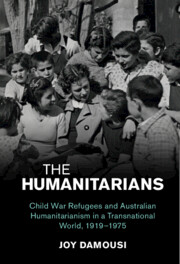 The Humanitarians
The Humanitarians Book contents
- The Humanitarians
- Studies in the Social and Cultural History of Modern Warfare
- The Humanitarians
- Copyright page
- Dedication
- Contents
- Acknowledgements
- Abbreviations
- Introduction
- Part I Saving
- Part II Evacuating
- Part III Assimilating and Adopting
- 7 Humanitarian Rights
- 8 Florence Grylls and Save the Children Fund
- 9 The Campaign for Japanese-Australian Children to Enter Australia
- 10 Humanitarian ‘Justice’
- 11 Humanitarian Activism During the Vietnam War
- Conclusion
- Select Bibliography
- Index
8 - Florence Grylls and Save the Children Fund
Humanitarianism in the Assimilation Era
from Part III - Assimilating and Adopting
Published online by Cambridge University Press: 28 July 2022
- The Humanitarians
- Studies in the Social and Cultural History of Modern Warfare
- The Humanitarians
- Copyright page
- Dedication
- Contents
- Acknowledgements
- Abbreviations
- Introduction
- Part I Saving
- Part II Evacuating
- Part III Assimilating and Adopting
- 7 Humanitarian Rights
- 8 Florence Grylls and Save the Children Fund
- 9 The Campaign for Japanese-Australian Children to Enter Australia
- 10 Humanitarian ‘Justice’
- 11 Humanitarian Activism During the Vietnam War
- Conclusion
- Select Bibliography
- Index
Summary
Save the Children was revived during the war and became a major organisation in dispersing funds to local children after the war, as discussed in Chapter 8. This signified a major shift in the role of the Fund in Australia, with localised branches working for the first time within Australia and in the Asian region. These activities directly impacted on Indigenous and migrant children, framed around the assimilation policies. The White Australia policy bound these endeavours. In Chapter 8 I consider two broad arguments. The first is that while the Save the Children branch developed a new localised identity, a form of imperial humanitarianism remained. My claim is that it did so through assimilation policies – which promoted an Australian way of life based on a White Britishness – that underpinned humanitarian work with Aboriginal children and war migrants. While this might not be surprising, it did make the Fund unique in post-war Australia. It was the only organisation that linked international humanitarianism to humanitarianism in Australia through its focus on Indigenous children and newly arrived war-refugee children. Arguably, these connections were possible only through a focus on children and the insistence that children were innocent, vulnerable victims across the globe. Second, this chapter continues the thread of examining the biography of lesser-known activists such as nurse Florence Grylls, which allows us to consider humanitarianism in action through attention to these campaigners.
- Type
- Chapter
- Information
- The HumanitariansChild War Refugees and Australian Humanitarianism in a Transnational World, 1919–1975, pp. 225 - 247Publisher: Cambridge University PressPrint publication year: 2022


